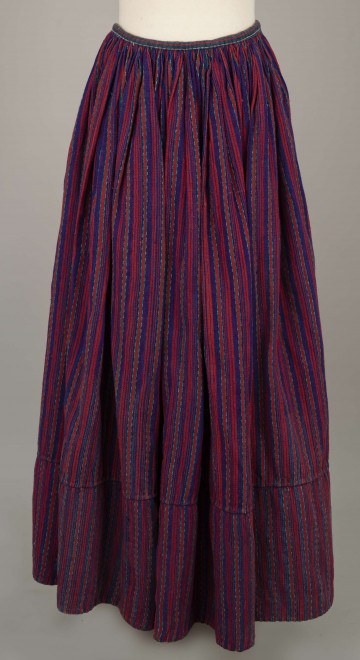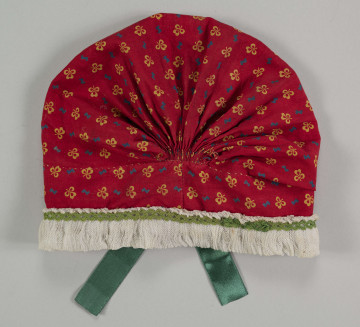
Women’s shirt
1900
National Museum in Lublin
Part of the collection: Folk craft of the Lublin Region (19th/20th c.)
The apron for the Radzyń festive costume (68 cm long, 104 cm wide) was sewn by hand from a single piece of cotton-wool fabric woven at a weaving workshop, with a grosgrain weave, in narrow stripes. The vertical stripes are white, navy blue, maroon and yellow. The apron in the upper part is finely creased and sewn into a stitch of a different colour, which has strings left to tie it at the back. The bottom is trimmed with a white cotton band.
Aprons have been used for centuries by women for everyday work and festive dress, as well as by certain craftsmen (bakers, butchers, blacksmiths, etc.), who wore them to protect other items of clothing. It therefore had a very practical function, protecting against dirt and damage to skirts, but it was also sometimes used for storing small items in pockets or for transporting larger quantities of goods, for example apples from the orchard (once they had been properly arranged). It also played a decorative role. Important in this case was the choice of colours, width of stripes and their arrangement, which differed in different regions, where fabrics of this type were produced. In the Radzyń Podlaski region they were woven in subdued colours, mainly dark, in small stripes with interwoven stripes in the colour of red, white and sometimes green. They were arranged vertically, less frequently horizontally.
Author / creator
Dimensions
cały obiekt: height: 104 cm, width: 68 cm
Object type
apron
Technique
hand sewing
Material
flax, wool
Creation time / dating
Creation / finding place
Owner
The National Museum in Lublin
Identification number
Location / status

1900
National Museum in Lublin

1890 — 1910
National Museum in Lublin

1923 — 1943
National Museum in Lublin
DISCOVER this TOPIC
Castle Museum in Łańcut
DISCOVER this PATH
Educational path